苏州园林英文PPt
苏州园林简介(英文)
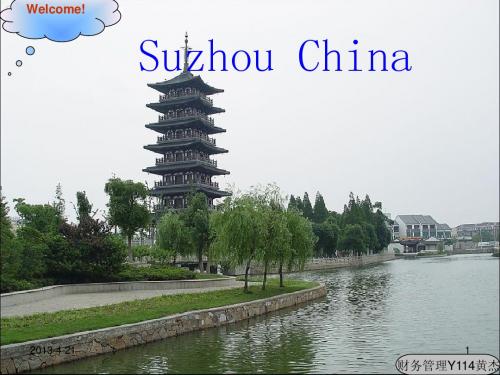
2012-2-24
6
Lotus Pond荷塘月色
2012-2-24 7
Lion Grove Garden狮子林
The Lion Grove Garden, covering an area of about 10,000 square meters, is right near the Humble Administrator's Garden. It was built in 1342 during the Yuan Dynasty. Lion Grove Garden is an ideal sightseeing site as it has richly ornamental pavilions and towers in different styles, each has its own history and story. The Garden is particularly well-known for the great quantities of its Taihu rocks that form an intriguing maze of mountain paths and varied scenes. 覆盖面积约10000平方米,狮子林,拙政园附近。在元代,它始 建于1342。狮子林是一个理想的观光的站点,因为它有丰富的 观赏亭和塔不同的风格,每个人都有自己的历史和故事。花园是 特别知名的大量太湖岩石山路和不同的场景形成了一个有趣的迷 宫。
拙政园,中国的四个最有名的花园之一,在1509建于明代,占 地约52,000平方米,是世界上最大和最负盛名的的。由于其独 特的设计和空灵之美,园林已经收购了许多特殊的荣誉。它被 列为世界文化遗产,也被指定为国家的重要性根据国家的保护, 以及作为中国的一个特别的旅游景点的文物之一。由东部,中 部和西部,以及一些前业主住宅花园。
苏州园林中英文介绍
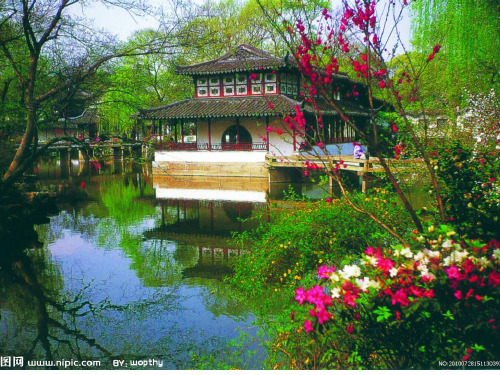
It began as an imperial flower garden in the Five Dynasty period. During the Ming dynasty the garden became a temple andlater fell into disrepair. The garden was reconstructed in the Qing dynasty, at which time it was expanded into the nearby fields and more buildings and other features were added
• 四、沧浪亭 • 沧浪亭地处城南三元坊,在现存苏州园林中,历 史最为悠久。全园景色简洁古朴,落落大方。沧 浪亭起初是五代时的御花园,明代时为寺院,后 来年久失修,直到清代才进行重建,面积扩大, 增添了新的建筑并且加入了新的风格。 • 4.Garden of Surging Wave Pavilion • Surging Wave Pavilion lies near Sanyuanfang in the south of Suzhou City and enjoys the longest history among all the existing gardens inn Suzhou. Surging Wave Pavilion is simple and unadorned in structure, and elegant and lively in patterns.
• 、
狮子林
• 狮子林是苏州最富盛名和最具代表性的四大古典 园林之一,其他三个是沧浪亭、留园和拙政园。 狮子林始建于元代,至今已有六百多年的历史了。 狮子林面积约10,000平方米,是旅游观光的理想 去处。其最引人入胜之处是假山,素有“假山王 国”之美誉。 • 3.Lion Grove Garden • Lion Grove Garden is one of the four most famous and representative gardens of ancient classical style in Suzhou City. The other three are Blue Wave Pavilion, Lingering Garden and Humble Administrator’s Garden. Built during the Yuan Dynasty, it has a history of more记:
苏州园林(英文版介绍)ppt课件

12
Why do we call it "荷 风四面亭?“
This pavilion is surrounded by the water and lotus flowers on four sides.
苏州园林
The Classical Gardens of Suzhou
1
Introduction
1.The hosts : rich men , painters, poets or officials etc. 2.The common methods:
barred views,framed views,borrowed views
……
13
The Listen to Rain Pavilion.
听雨轩
"轩“ ,a small ,high and ventilated (通风) room a ,always has the big,long windows.
14
In the room
A scene of antiquity(古色古
3.The main architecture types are: pavilion(亭,轩,榭,阁),terrace(台),hall (堂,馆) ,tower(楼)corridor(廊)
亭台楼阁轩榭廊堂馆
2
Introduction
4.There are four very famous classical gardens of suzhou:
苏州园林英语介绍(IntroductiontoGardenEnglishinSuzhou)

苏州园林英语介绍(Introduction to Garden English in Suzhou)苏州古典园林(苏州园林英语介绍)苏州园林,英语,古典园林,苏州位于江苏省的东南部。
该市成立为吴州的首府战国的东周时期,公元前c.476-221。
在中国与很多大运河运河是隋朝,在建的苏州的繁荣,成为丝绸贸易中心。
宋朝时期,邻近的杭州成为帝国首都,苏州也发展起来,是学者、官员和商人的方便之地。
马可波罗参观了“苏洲”,谈到了这个城市的规模、繁荣、丝绸贸易和“6000石桥”。
他说这个城市的名字是“地球”,还有一个被称为“天堂”的附近城市。
其他早期消息来源称苏州为“人间天堂”。
苏州园林在明、清两代时期达到鼎盛时期。
当时在苏州有280多个私人花园,园林绿化成了一门艺术。
气候温和,230天无霜期,每年降雨量约43英寸,是园艺工作的理想场所。
苏州及周边地区的六十九所花园仍处于良好状态。
1997,教科文组织将四的苏州私家园林列入世界遗产名录,并于2000扩展到该城市历史区和该地区其他五个花园。
北宋沧浪亭碧波亭,沧浪亭,苍朗婷碧波亭是苏州现存最古老的私家园林。
它开始于五代时期的皇家园林。
苏舜沁,一个诗人,在北宋的高等法院法官,买房子,建了一座亭子旁边的水。
当他离开办公室时,他住在那里,写的文章后来被收集在一本书中称为学者苏的著作。
在南宋韩世忠曾经Nuzhen Tartars著名将领,靠物业。
明朝时,花园成了寺庙,后来年久失修。
这座花园在清朝重建,当时它被扩建到附近的田地里,增加了更多的建筑物和其他特色。
苏州的大部分花园都被城墙包围着,这个湖的中心是一个大的湖和它的小溪。
重点是面对水亭,它位于水的边缘。
在花园的中央有一座微型山,在南端有一座较小的山。
有二十栋建筑,和整个花园的一些石碑和平板电脑,以及非常古老的树木和竹类十八种。
元代狮子林狮子林,石子琳狮子林始建于1342为寺庙园林的菩提正宗寺的一部分。
在明代,它吸引了佛教学者、画家和诗人。
苏州四大名园英文版
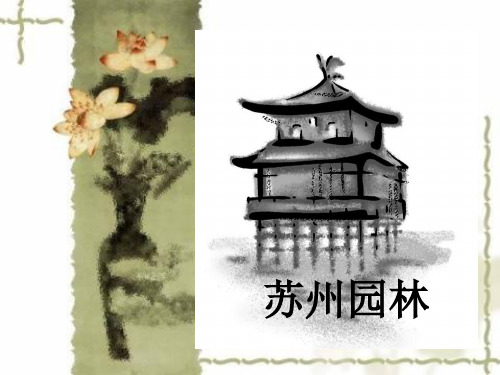
• The Lingering Garden(留园) • The Lion Gorest Garden(狮子林) • The CangLang Pavilion Garden(沧
浪亭)
The Humble Administrator's Garden
苏州园林
苏州园林 The Classical Gardens of Suzhou
The Classical Gardens of Suzhou is the best in Jiangnan.
苏州园林甲江南
Gardens of suzhou
上
下
有
有
天
苏
堂
杭
Suzhou’s
four greatest gardens
Hale Waihona Puke •The HumbleAdministrator's
芙
Garden, is one of China's four
蓉 most famous
榭
gardens, built in 1509 during the
Ming Dynasty
枇杷园 倒影楼
the Lingering Garden 留园
The garden is se parated into the middle ,eastern,n orthern and west ern parts. The an cestral temple and the h ouse lie to the so uth of the garden.
The Lion Forest Garden 狮子林
演示文稿苏州园林 英语
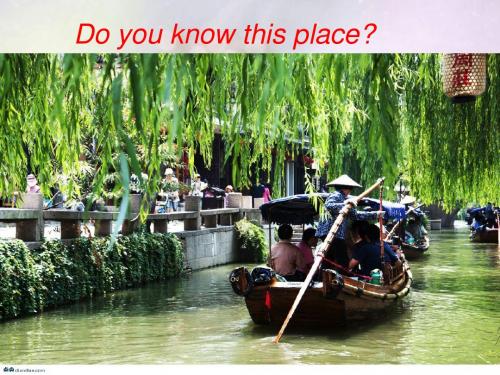
Suzhou is the most vigorous, creative and advanced in development city which is located ”. in Jiangsu . Suzhou is divided into three parts“lao Suzhou", “xin Suzhou" and “yang Suzhou”. Suzhou has changed in size, industry, environment, and architecture.
Do you know this place?
The transition of Suzhou
The changes in size
In the past, the majority of people reckon that Suzhou is a so small city that once a poet wrote a poem to describe it. Many years ago, it showed that it was only a garden city and it just had bridge, water and small pavilion . But now it has developed a big city. It not only is a garden but also builds new and industry district. In addition, afterwards Its scale expends two times, and now it has presented a new look.
The environment of Suzhou
苏州园林英文PPt

TniQaUoLSarowtnehondhuuffsiitcetnndemmimotlhrnahggewSkg1mietetaneheoue7hrtviKeoYesmmr6sieiourkuutt4aIrpymCsnanPmsnaaenahmaoHtdtepsrlilirfrvoadiniaeflmtnemclureyPdhrge,ainnsaoQeiaartselacucLleinaiGotsaotanGspcihtnwoanikmethyaderaaelni’irodetibill,dsnbnohnnehitsenaswshngtBann,osiceeaielaiiaotbpldcnlcsihtfp,fjehuooifipsaanitCnyrrtnrpwnocageamlcoaceidml.lereioiafetiaenltipeiarrrvbcnuntdwaneeaRardaave1ddglolilanip,s7asrlrnbeiacapck5noerncyat,l0dnveeipdtntossshheg.iere
On the whole the present garden of the Canglang Pavilion still keeps the style of the Song.It features a range of man-made moutains inside the garden and waterscapes outside.Proceeding past the pure expanse of water over a zigzag bridge of stone and through the entrance,one comes to the garden and catches sight of man-made mountain covered with age-old trees and bamboo,running from east to west
园林专业英语课件

Ample connotation of social culture
Suzhou garden are the carrier of traditional Chinese philosophy. The naming of the gardens, the hall hoards(匾 额) and pillar couplets(楹联), the calligraphy stone slabs(书 条石), carvings(雕刻), and decorations, are not only line ornaments but also a wealth of history, culture, philosophy, and science.
——WHC, UNESCO
Precious cultural heritages of the world
The history of Suzhou classical gardens dates back to the garden of King of Wu in the 6th century, whereas the earliest record of private gardens was found to be Pijiang (Territory Developing) Garden in East Jin Dynasty. Famous garden grew in number with the time and by Ming and Qing Dynasty they were everywhere in Suzhou and dozens of them have survived intact to the present.
苏州英文介绍ppt课件

寒山寺 Cold Mountain Temple
虎丘 Tiger Hill Pagoda
8
枫桥 Maple
9
同里
木 渎
10
天平山 Tian Ping Mountain
In autumn , there are many maple trees on the mountain and family members will go there together. At the same time, they should take delicious food、tasty drink and so on. They are talking to each other while seeing the maple leaves. The last but not the least , it is essential to increase the emotion in f现方式做保护处理对用户上传分享的文档内容本身不做任何修改或编辑并不能对任何下载内容负责
My Hometown
——Su Zhou
1
Su Zhou is best known for its gardens
The four famous gardens:
5
沧浪亭 CangLang Pavilion
6
There are many other places , such as Tiger Hill Pagoda , Cold Mountain Temple , Maple , Two tradition Town “木渎” and “同里” . If you have enough energy , and want to see views from above. Maybe the mountain is a better choice . Therefore , Tian Ping Mountain and Ling Yan Mountain are suitable for you.
苏州园林(Gardens_in_Suzhou)
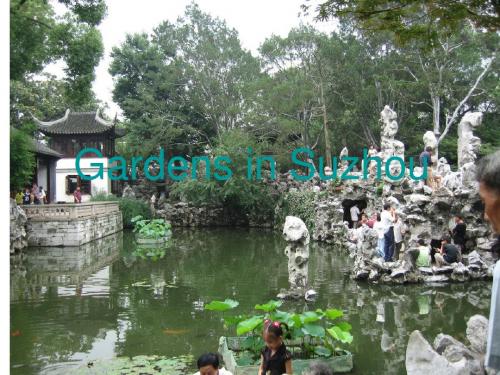
Lions are quite lazy creatures, and spend as much as 20 hours a day resting! Females do most of the hunting, and often work together in groups. They usually hunt during the day and prey upon mammals like antelope and zebra. The phrase 'the lion's share' comes from the males' habit of eating before the rest of the pride.
In recent years, Zhuozhengyuan Garden tap traditional culture, launched its own characteristics flowers Azalea Festival held each spring and summer seasons and calendar; flowers bloom, Hsieh Yuan Yi, so simple and elegant classical garden full of vitality quiet.
The Lingering Garden is located at Liuyuan road, outer Lumen Ave Suzhou City, Jiangsu Province.
The Lingering Garden is one of the four classical gardens in Suzhou City. In the Jianing reign of the Ming Dynasty (13681644), an official named Xu Jiongqing from the Taipu Temple built two gardens here: one in the east and the other in the west. The one in the east is the predecessor of today's .
苏州园林(英文版介绍)ppt

Barred Views
Why did the encient people did that?
The reason relates to the chinese people's chaaraters and culture .
Chinese people are reserved and indirect ,so they don't want people to see all wonderful views at a time.
The Humble Administratorபைடு நூலகம்s Garden(拙政园) The Lingering Garden(留园) The Lion Gorest Garden(狮子林) The CangLang Pavilion Garden(沧浪亭)
All of them have been included in World Cultural Heritage List (世界文化遗产名录)since the end of 1997. Among these gardens ,The Humble Administrator's Garden is the most famous and biggest garden which shows the all typical characters of the classical garden. so i will take this garden for example to show you what the classical garden of suzhou is?
喻) ,using the object to
express his thoughts(托
苏州园林英文PPt
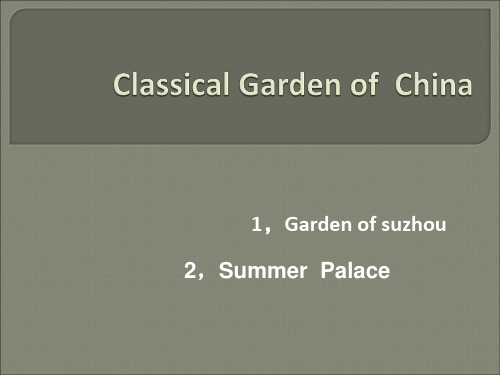
The
middle part of the garden is centered upon a lake with man-made mountain in the north-west and a number of attractive buildings in the southwest.
northern part is now a bonsai garden in which about 500 valuable bonsai are put on display.
The
western part of the garden sets a fine example of goodlooking earthen hills studded with yellowstones and covered with maple trees.There is a winding brook lined with peach trees and weeping willows.
Fine
buildings occupy most of the eastern section.The Cloud-Capped Peak,6.5-meterhigh ,is the highest limestone in the classical gardens of suzhou.
The
the Humble Administrator's Garden
The garden contains numerous pavilions and bridges set among a maze of connected pools and islands. It consists of three major parts set about a large lake: the central part (the eastern part and the western
苏州园林-PPT课件
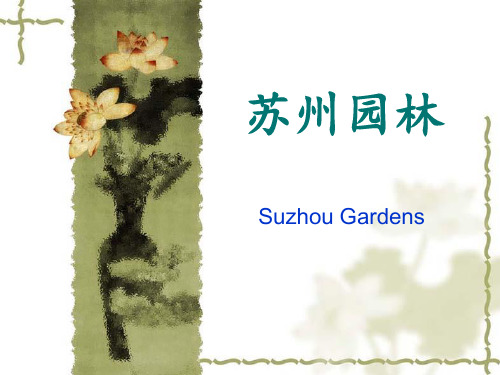
丰富的社会文化内涵
苏州园林的重要特色之一,在于它不仅 是历史文化的产物,同时也是 中国传统思想文化的载体。表现在园林 厅堂的命名、匾额、楹联、书条石、雕 刻、装饰,以及花木寓意、叠石寄情等, 不仅是点缀园林的精美艺术品,同时储 存了大量的历史、文化、思想和科学信 息,其物质内容和精神内容都极其深广。 其中有反映和传播儒、释、道等各家哲 学观念、思想流派的;有宣扬人生哲理, 陶冶高尚情操的;还有借助古典诗词文 学,对园景进行点缀、生发、渲染,使 人于栖息游赏中,化景物为情思,产生 意境美,获得精神满足。而园中汇集保 存完好的中国历代书法名家手迹,又是 珍贵的艺术品,具有极高的文物价值。 另外,苏州古典园林作为宅园合一的第 宅园林,其建筑规制又反映了中国古代 江南民间起居休亲的生活方式和礼仪习 俗,是了解和研究古代中国江南民俗的 实物资料。
苏州气候
苏州地处温带,四季分明,气候温和,雨量充沛。属北亚热带湿润季风气候, 年均降水量1100毫米,年均温15.5℃,1月均温2.5℃。7月均温28℃。 全市地势低平,平原占总面积的55%,水网密布,土地肥沃,物产丰富,雨 量充沛,平野稻香,碧波鱼跃,农副物产十分丰富,人们传诵的“近炊香稻识红 莲”、“桃花流水鳜鱼肥”、“夜市买菱藉,春船载绮罗”的诗句,就是历代诗人对 苏州物产富足的赞美和讴歌。
完美的居住条件与生活环境
苏州古典园林宅园合一,可赏,可游, 可居,这种建筑形态的形成,是在人口密 集和缺乏自然风光的城市中,人类依恋自 然,追求与自然和谐相处,美化和完善自 身居住环境的一种创造。拙政园、留园、 网师园、环秀山庄这四座古典园林,建筑 类型齐全,保存完整,系统而全面地展示 了苏州古典园林建筑的布局、结构、造型、 风格、色彩以及装修、家具、陈设等各个 方面内容,是明清时期(14~20世纪初) 江南民间建筑的代表作品,反映了这一时 期中国江南地区高度的居住文明,曾影响 到整个江南城市的建筑格调,带动民间建 筑的设计、构思、布局、审美以及施工技 术向其靠拢,体现了当时城市建设科学技 术水平和艺术成就。
Suzhou Gardens 苏州园林
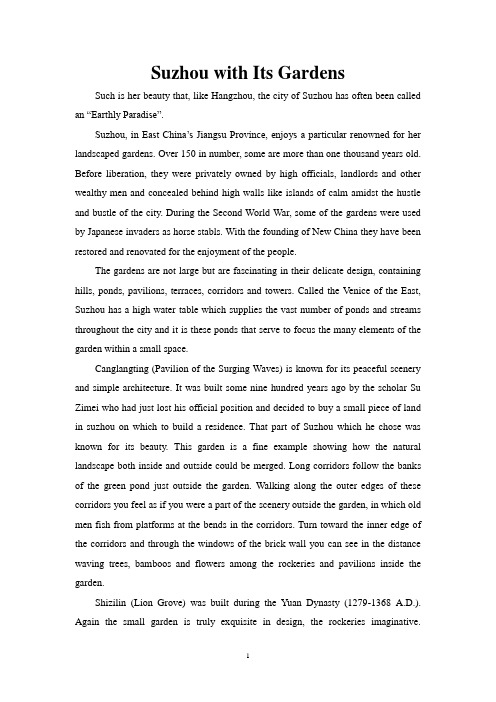
Suzhou with Its GardensSuch is her beauty that, like Hangzhou, the city of Suzhou has often been called an “Earthly Paradise”.Suzhou, in East China’s Jiangsu Province, enjoys a particular renowned for her landscaped gardens. Over 150 in number, some are more than one thousand years old. Before liberation, they were privately owned by high officials, landlords and other wealthy men and concealed behind high walls like islands of calm amidst the hustle and bustle of the city. During the Second World War, some of the gardens were used by Japanese invaders as horse stabls. With the founding of New China they have been restored and renovated for the enjoyment of the people.The gardens are not large but are fascinating in their delicate design, containing hills, ponds, pavilions, terraces, corridors and towers. Called the V enice of the East, Suzhou has a high water table which supplies the vast number of ponds and streams throughout the city and it is these ponds that serve to focus the many elements of the garden within a small space.Canglangting (Pavilion of the Surging Waves) is known for its peaceful scenery and simple architecture. It was built some nine hundred years ago by the scholar Su Zimei who had just lost his official position and decided to buy a small piece of land in suzhou on which to build a residence. That part of Suzhou which he chose was known for its beauty. This garden is a fine example showing how the natural landscape both inside and outside could be merged. Long corridors follow the banks of the green pond just outside the garden. Walking along the outer edges of these corridors you feel as if you were a part of the scenery outside the garden, in which old men fish from platforms at the bends in the corridors. Turn toward the inner edge o f the corridors and through the windows of the brick wall you can see in the distance waving trees, bamboos and flowers among the rockeries and pavilions inside the garden.Shizilin (Lion Grove) was built during the Yuan Dynasty (1279-1368 A.D.). Again the small garden is truly exquisite in design, the rockeries imaginative.Entering the garden you find stones in various interesting shapes. Look at them closely. They are lions: lying, sitting, slinking along, standing on hind legs, embracing a ball made of strips of silk.Zhuozhengyuan (The Humble Administrator’s Garden), the largest in the city, is a lush and distinctive garden. Built in the Ming Dynasty (1368-1644 A.D.), Zhuozhengyuan consists of three sections: east, west and central. The garden in the center is the most picturesque. Here you may sit in Yuanxiangting (Distant Fragrance Pavilion) beside the lotus pond. Also known as the “Four-sided” Pavilion, it is open on all sides to the garden and many other pavilions, rockeries, and winding bridges. The bank of the lotus pond is lined with willows, thus creating an atmosphere of peace and seclusion. Follow a winding path up a small hill and you will find at the top a wood tablet upon which is inscribed “Between Mountain Flowers and Wild Birds”. There are antithetical couplets on both sides. On the left, “Cicadas, chirping, make the forest all the more peaceful.” On the right, “Birds, singing, make the mountain all the more secluded.” The calligraphy is that of Wen Zhengming, a famous painter of the Ming Dynasty. Beautiful brick carvings and relief sculptures adorn the walls of many of the structures.Liuyuan (Garden to Linger in) was constructed in the Qing Dynasty (1644-1911 A.D.) and is three hectares in size. Winding throughout the garden is a 700-meter long corridor, on the walls of which are a great number of stone carvings and windows.Within the garden is “Y et Another Village”, a winding path with a trellised grape vine canopy. All along the path are hundreds of potted flowers and trees, some as much as three hundred years old. Liuyuan boasts the largest rock in Suzhou. It is six and a half meters high, weighs five tons and was transported from Lake Taihu four hundred years ago. Because of its height and shape it was named “Cloud-capped Peak”. Limesto ne boulders like this were quarried from mountains around the lake where the masterful hand of nature had cut them into strange shapes with cavities and grooves. These are the rocks that are used in the landscaping of many famous gardens throughout the country.。
- 1、下载文档前请自行甄别文档内容的完整性,平台不提供额外的编辑、内容补充、找答案等附加服务。
- 2、"仅部分预览"的文档,不可在线预览部分如存在完整性等问题,可反馈申请退款(可完整预览的文档不适用该条件!)。
- 3、如文档侵犯您的权益,请联系客服反馈,我们会尽快为您处理(人工客服工作时间:9:00-18:30)。
northern part is now a bonsai garden in which about 500 valuable bonsai are put on display.
The
western part of the garden sets a fine example of goodlooking earthen hills studded with yellowstones and covered with maple trees.There is a winding brook lined with peach trees and weeping willows.
Fine
buildings occupy most of the eastern section.The Cloud-Capped Peak,6.5-meterhigh ,is the highest limestone in the classical gardens of suzhou.
The
The
middle part of the garden is centered upon a lake with man-made mountain in the north-west and a number of attractive buildings in the southwest.
1,Garden of suzhou 2,Summer Palace
den of suzhou
the Humble Administrator's Garden
the Humble Administrator's Garden
The Humble Administrator‘s Garden is a renowned Chinese garden in Suzhou. At 51,950 m2, it is the largest garden in Suzhou and is considered by some to be the finest garden in all of southern China In 1997.
The remaining 90% of the garden provides areas for enjoying views and spiritual contemplation and is embellished with garden buildings including the Tower of the Fragrance of Buddha, the Tower of the Revolving Archive, Wu Fang Pavilion, the Baoyun Bronze Pavilion, and the Hall that Dispels the Clouds. Kunming Lake contains three large islands, corresponding to the traditional Chinese symbolic mountain garden element, the southern of which is linked to the East Dike by the Seventeen Arch Bridge. Pleasure to the north-east. An essential feature is the West Dike with six bridges in different styles along its length. Other important features include temples and monasteries in Han and Tibetan style located on the north side of the Hill of Longevity and the Garden of Harmonious
The eastern part The middle part The western part
the Humble Administrator's
Garden
the Lingering Garden
The garden is well-known for its artistic way of dealing with the spaces between various kinds of architectural form, with an area of 23,310 sq.m. Construction of the Lingering Garden began during the Ming dynasty by XuTaishi,a high-ranking official in charge of the emperor’s horses and vehicles.
Summer Palace, an Imperial Garden in Beijing
The
Summer Palace in Beijing – first built in 1750, largely destroyed in the war of 1860 and restored on its original foundations in 1886 – is a masterpiece of Chinese landscape garden design. The natural landscape of hills and open water is combined with artificial features such as pavilions, halls, palaces, temples and bridges to form a harmonious ensemble of outstanding aesthetic value.
The central feature of the Administrative area, the Hall of Benevolence and Longevity is approached through the monumental East Palace Gate. The connecting Residential area comprises three building complexes: the Halls of Happiness in Longevity, Jade Ripples and Yiyun, all built up against the Hill of Longevity, with fine views over the lake. These are linked by roofed corridors which connect to the Great Stage to the east and the Long Corridor to the West. In front of the Hall of Happiness in Longevity a wooden quay gave access by water for the Imperial family to their quarters.
On the whole the present garden of the Canglang Pavilion still keeps the style of the Song.It features a range of man-made moutains inside the garden and waterscapes outside.Proceeding past the pure expanse of water over a zigzag bridge of stone and through the entrance,one comes to the garden and catches sight of man-made mountain covered with age-old trees and bamboo,running from east to west
Destroyed during the Second Opium War of the 1850s, it was reconstructed by Emperor Guangxu for use by Empress Dowager Cixi and renamed the Summer Palace. Although damaged again during the Boxer Rebellion in 1900 it was restored and has been a public park since 1924.
According
to the style of the buildings, the garden can generally be divided into four parts: the central, eastern, western and northern partsQing Dynasty
Celebrated for the delights of the wilderness of mountain and forest scenery,the Canglang Pavilion is the oldest among the existing classical gardens of Suzhou
The Lion Grove Garden, covering an area of about 10,000 square meters, is right near the Humble Administrator's Garden. It was built in 1342 during the Yuan Dynasty. Lion Grove Garden is an ideal sightseeing site as it has richly ornamental pavilions and towers in different styles, each has its own history and story
